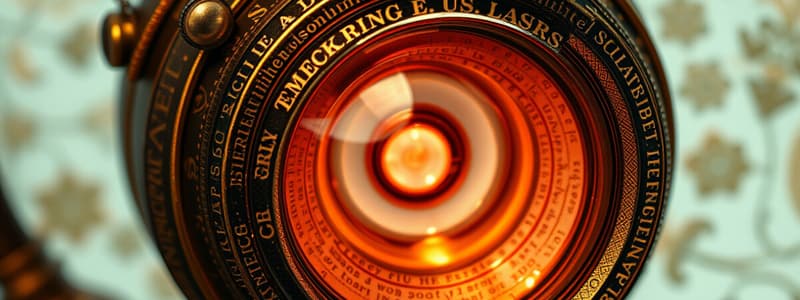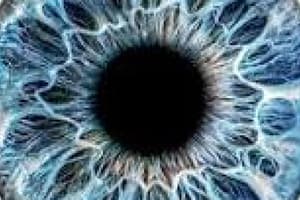Podcast
Questions and Answers
What is the magnifying power of ocular lenses (eyepieces)?
What is the magnifying power of ocular lenses (eyepieces)?
- 5x
- 20x
- 15x
- 10x (correct)
What does the body tube do?
What does the body tube do?
Holds nosepiece at one end and eyepiece at the other end; conducts light rays.
What is the purpose of the arm of the microscope?
What is the purpose of the arm of the microscope?
Supports upper parts and provides a carrying handle.
What does the nosepiece hold?
What does the nosepiece hold?
What is the magnification power of the scanning objective lenses?
What is the magnification power of the scanning objective lenses?
What is the magnification power of low-power objective lenses?
What is the magnification power of low-power objective lenses?
What is the magnification power of high-power objective lenses?
What is the magnification power of high-power objective lenses?
What is the purpose of oil immersion objective lenses?
What is the purpose of oil immersion objective lenses?
What is the function of the coarse adjustment knob?
What is the function of the coarse adjustment knob?
What is the function of the fine adjustment knob?
What is the function of the fine adjustment knob?
What is the purpose of the condenser in a microscope?
What is the purpose of the condenser in a microscope?
What does the diaphragm control?
What does the diaphragm control?
What is the function of the light source?
What is the function of the light source?
What is the base of the microscope?
What is the base of the microscope?
What does the stage do?
What does the stage do?
What are stage clips used for?
What are stage clips used for?
What is a mechanical stage in a microscope?
What is a mechanical stage in a microscope?
Flashcards are hidden until you start studying
Study Notes
Microscope Parts and Functions
- Ocular Lenses (eyepieces): Magnification power of 10x.
- Body Tube: Connects the eye piece to the nosepiece and channels light.
- Arm: Supports upper components; serves as a handle for carrying.
- Nosepiece: Revolving mechanism for holding multiple objective lenses.
Objective Lenses
- Scanning Objective Lens: Shortest lens used for initial scanning, magnification power of 4x.
- Low-power Objective Lens: Longer than scanning lens, provides detail with magnification of 10x.
- High-power Objective Lens: Longest lens for higher detail, magnification power of 40x.
- Oil Immersion Objective Lens: Contains a 95x lens, used with immersion oil for maximum magnification.
Focusing Mechanisms
- Course Adjustment Knob: Used for initial focus, only compatible with low power objectives.
- Fine Adjustment Knob: Refines focus to achieve clarity on the specimen.
Light and Stage Components
- Condenser: Positioned below the stage, it focuses light onto the specimen for better visibility.
- Diaphragm: Regulates light intensity to optimize viewing conditions.
- Light Source: Provides illumination through the object being observed.
Structural Components
- Base: The grounded portion of the microscope that stabilizes it on the table.
- Stage: The platform holding slides for observation.
- Stage Clips: Keep slides secured on the stage.
- Mechanical Stage: Facilitates precise slide positioning through adjustable mechanisms.
Studying That Suits You
Use AI to generate personalized quizzes and flashcards to suit your learning preferences.



